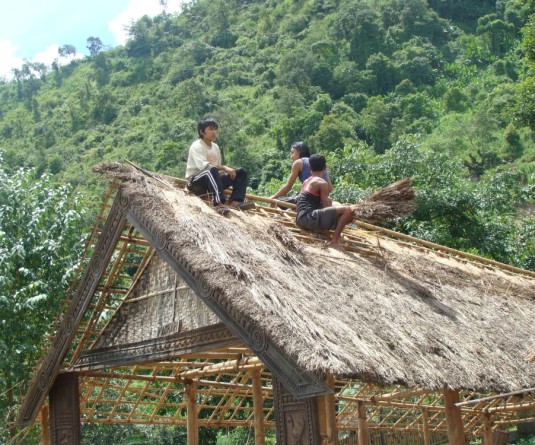A young girl running errands carrying her younger brother on her back at Waoshu Village, a Chang Naga village, Tuensang District. Photo: Toshi Kichu
.jpg)
Waoshu village in Tuensang have been demanding up-gradation of their only primary school for 3 years
Limasenla Jamir
Mokokchung | January 19
A young girl carries her younger brother on her back and watches an ongoing football match at the village ground while seven to eight young boys play with a pig’s bladder by the roadside with their face smeared with mucus and their winter cheeks red and cracked.
Another girl, Donnen, the youngest among nine siblings, sits near the fire place and watches her father sing folk songs, while her sisters are out fetching water and running errands. Forty-two kilometers away from Tuensang town, Waoshu village, a Chang Naga village, sits on a hill top with about 115 households and a population of more than 500.
A family here has an average of six children. With about twenty-three percent of the population belonging to the age group of 0-6 years, the village has one Government Primary school with six classroom and four teachers. A very uncommon phenomenon in Nagaland, the village faces the problem of absentee teachers and lack of teachers in the school.
While talking about the problem of education in the village, the Village Council Chairman of Waoshu said that the school faces a lot of problems starting from absentee teachers to lack of teachers in the school. The chairman hinted that the teachers including the headmaster are mostly engaged in government duty, which mostly involves census collection, instead of doing their job of teaching.
Children constitute 20 percent to the village population, but the existence of just one primary school makes it difficult for the parents to send their children for further education. Some go and stay at their relatives’ places in Tuensang town; many are sent off to other districts as domestic workers and helpers, as a means of getting further education, while many others who cannot afford to send their children drop out at the primary school level due to the absence of middle and high school in the village.
When the village inaugurated a new school building in 2012, a letter was forwarded for the up gradation of the primary school to middle school. But it has been three years without any response from the government.
Parents in the village have now changed their perspective on education and understand the value of sending their children to school. There was a time when parents would barge into the classroom and leave their toddlers with their older children if they happen to be in class, while some of the students would come to the schools with their work baskets and run to the fields as soon as they could escape from the classroom, narrates Ayin, whose wife is an adhoc teacher in the village school for more than ten years now.
Apart from the education, the village, like any other in the eastern part of Nagaland, is plagued by deplorable road conditions, sanitation problems, water scarcity and electricity problems to name a few. The Waoshu Village Council with its small funds for the development of the village maintains the road that connects them to the outside world.
At a time when connectivity of people through technology and infrastructure is revolutionizing the communication paradigm, the people of Washou village remain deprived and excluded. Newspapers are non-existent in the village. Owning a cell phone is a prized possession for them, though they have to climb hills or stand at certain points to get through the network.
The villagers feel they are being ignored by the state government. The only time politicians visit their village is during elections, and once they are elected, they seldom see their face. When the DEO of Tuensang district inaugurated their school building, they hoped that the primary school would soon be upgraded to a middle school. But three years of inaction have evaporated that hope.
It is pertinent to mention that the village is only 42 kilometers from an administrative town. This serves as an indication of the conditions that are faced by villages which are even more remote.






